A question of scale
The subject of ‘scale’ is one of those tricky topics best approached with caution, ideally from the flank or even better from behind just to be safe. Head on is never a good idea. I’ve seen many a simple and innocent question on an online group descend into angry and bitter debate as each side bravely defends their fixed positions. What simple subject could cause such a calamity? Why, the question of scale - “Do I use 1/56 or 1/48 scale vehicles for my 28mm figures?”

Now I should openly state before we go any further that my preference is for 1/56. Some people already will be saying “You are wrong”, but let’s look at why. I will try and tackle this subject with only a little bias, so please read on. Let’s first consider the concept of the ‘average man’. If we are to use a scale we need to know what be base line is. The current average height for a man in the UK is 1.75 metres (5 feet 9 inches). However in the Netherlands it is 1.85 metres (over 6 feet) - Holland is one of the few places I feel short (standing as I do at 1.83 metres or 5ft 11”). The averages for soldiers in World War 2 only add additional complications. The average US soldier was 5 feet 8 inches (some sources say 5 feet 7 inches) but the Japanese man was 5 feet 3 inches… Oh dear… so which one do we choose? Do we add the height of boots to this? I guess we have to… So let’s go with 1.75 metres…

Slapton Sands Sherman. 75mm as above.
There are further obstacles we face, namely that ‘28mm’ is not a scale. It is an arbitrary measurement so wargamers have a (rough) guide to the size of the miniatures. ‘28mm’ is itself an invention, as one manufacturer decided to separate themselves from the crowd which some 20 years ago was calling everything ‘25mm’! Even then, in reality, the definition of what constitutes ‘28mm’ varies widely, as the themed review section of any Wargames, Soldiers and Strategy will tell you. To me, this is ‘okay’, as people do vary in size naturally, so mixing and matching different height models (from different manufacturers) is fine, as this is exactly the sort of variation you’ll see just walking down the average high street.

Rick Priestley’s excellent article in WSS 55 opens this can of worms and makes for interesting reading. So ‘28mm’ works out (if an average man is 1.75 metres) then the ‘scale’ is 1/62… But wait - your ‘average 28mm’ actually stands 30 to 31mm tall. Then 1750 millimetres divided by 30mm translates to a ’scale’ of 1/58, while 31mm translates as 1/56… (hmm sound familiar?). Now if you believe your strapping SS are all 6 feet tall (1.85 metres), bizarrely the scale goes down (1/59). There are other effects in play we need to discuss, such as the basing of the model which will add artificial height to a model (but if you base your models, surely you should base your vehicles as well?). Then there’s the type of sculpting (‘realistic’ versus ‘heroic’) which I will discuss in my next blog. I think the best conversation I had was with Paul of Blitzkrieg miniatures - he really didn’t want to get involved in the arguments of either camp and thus provides his models in 1/72, 1/56 and 1/48!

